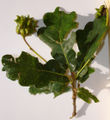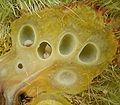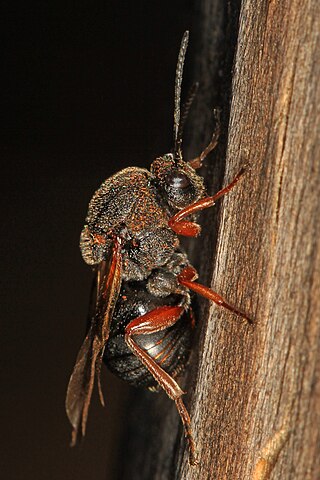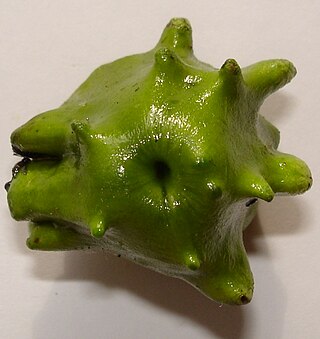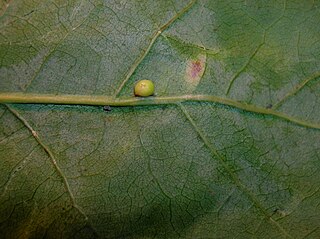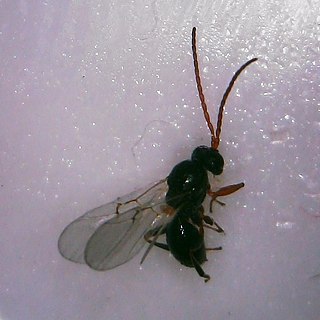Taxonomic range
Plant galls are caused by a wide range of organisms, including animals such as insects, mites, and nematodes; fungi; bacteria; viruses; and other plants.
Insects
Insect galls are the highly distinctive plant structures formed by some herbivorous insects as their own microhabitats. They are plant tissue which is controlled by the insect. Galls act as both the habitat and food source for the maker of the gall. The interior of a gall can contain edible nutritious starch and other tissues. Some galls act as "physiologic sinks", concentrating resources in the gall from the surrounding plant parts. [25] Galls may also provide the insect with physical protection from predators. [35] [24]
Insect galls are usually induced by chemicals injected by the larvae of the insects into the plants and possibly mechanical damage. After the galls are formed, the larvae develop inside until fully grown, when they leave. To form galls, the insects must take advantage of the time when plant cell division occurs quickly: the growing season, usually spring in temperate climates, but which is extended in the tropics.
The meristems, where plant cell division occurs, are the usual sites of galls, though insect galls can be found on other parts of the plant, such as the leaves, stalks, branches, buds, roots, and even flowers and fruits. Gall-inducing insects are usually species-specific and sometimes tissue-specific on the plants they gall.
Gall-inducing insects include gall wasps, gall midges, gall flies, leaf-miner flies, aphids, scale insects, psyllids, thrips, gall moths, and weevils. [36]
Many gall insects remain to be described. Estimates range up to more than 210,000 species, not counting parasitoids of gall-forming insects. [37]
Cynipid wasps
More than 1400 species of cynipid wasps cause galls. Some 1000 of these are in the tribe Cynipini, their hosts mostly being oak trees and other members of the Fagaceae (the beech tree family). [37] These are often restricted taxonomically to a single host species or a group of related species.
- Cynipid wasp galls
- Oak artichoke gall caused by Andricus foecundatrix
- Artichoke gall cut open to reveal wasp larva
- Knopper gall caused by Andricus quercuscalicis
- Oak gall caused by Neuroterus albipes forma laeviusculus
- Marble gall of oak caused by Andricus kollari
- Cherry oak gall caused by Cynips quercusfolii
- Cherry oak gall cut open to reveal wasp larva
- Cherry oak gall wasp adult
- Red-pea gall (Cynips divisa) on pedunculate oak
- Cola-nut galls ( Andricus lignicola ) on pedunculate oak
- Kokkocynips rileyi oak gall
- Phylloteras poculum oak galls
Non-cynipid wasps
Some wasps from other groups, such as the Diplolepididae and the Chalcidoidea, also cause plant galls.
- Non-cynipid wasp galls
- Section through young bedeguar gall showing wasp larvae and cells
Hemipteran bugs
Among the hemipteran bugs that cause galls are the psyllid bug Pachypsylla celtidisumbilicus , and the woolly aphid Adelges abietis , which parasitises coniferous trees such as the Sitka spruce and the Norway spruce.
- Hemipteran galls
- Developing pineapple pseudocone galls on Norway spruce, caused by woolly aphid Adelges abietis
- Pineapple gall cut open to show the woolly aphid larvae inside
- Pineapple gall on Sitka spruce caused by Adelges abietis
- Pachypsylla celtidisumbilicus hackberry gall
Dipteran flies
Some dipteran flies such as the cecidomyiid gall midges Dasineura investita and Neolasioptera boehmeriae , and some Agromyzidae leaf-miner flies cause galls.
- Midge galls
- Nettle gall caused by Dasineura investita (Cecidomyiidae)
- False nettle stem gall caused by gall midge Neolasioptera boehmeriae (Cecidomyiidae)
- Schizomyia impatientis (Cecidomyiidae) jewelweed flower gall
Mites
Mites, small arachnids, cause distinctive galls in plants such as the lime tree.
- Mite galls
- Lime nail galls caused by the mite Eriophyes tiliae
Nematodes
Nematodes are microscopic worms that live in soil. Some nematodes (Meloidogyne species or root-knot nematodes) cause galls on the roots of susceptible plants. The galls are often small. [38] [39]
- Nematode galls
- Juvenile Meloidogyne penetrating a host plant
- Root-knot galls caused by the nematode Meloidogyne
Fungi
Many rust fungi induce gall formation, including western gall rust, which infects a variety of pine trees and cedar-apple rust. Galls are often seen in Millettia pinnata leaves and fruits. Leaf galls appear like tiny clubs; however, flower galls are globose. Exobasidium often induces spectacular galls on its hosts.
The fungus Ustilago esculenta associated with Zizania latifolia, a wild rice, produces an edible gall highly valued as a food source in the Zhejiang and Jiangsu provinces of China. [40]
- Fungal galls
- Leaf galls on Rhododendron ferrugineum caused by fungus Exobasidium rhododendri
Bacteria and viruses
Gall-causing bacteria include Agrobacterium tumefaciens and Pseudomonas savastanoi .
Gall forming virus was found on rice plants in central Thailand in 1979 and named rice gall dwarf. Symptoms consisted of gall formation along leaf blades and sheaths, dark green discoloration, twisted leaf tips, and reduced numbers of tillers. Some plants died in the glasshouse in the later stages of infection. The causal agent was transmitted by the hemipteran bug Nephotettix nigropictus after an incubation of two weeks. Polyhedral particles of 65 nm diameter in the cytoplasm of phloem cells were always associated with the disease. No serologic relationship was found between this virus and that of rice dwarf.
- Microbial pathogen galls
- Crown gall on Kalanchoe infected with Agrobacterium tumefaciens
- Citrus vein enation woody gall on Fortunella japonica caused by a pathogen with an aphid vector
Plants
The hemiparasitic plant mistletoe forms woody structures sometimes called galls on its hosts. [41] More complex interactions are possible; the parasitic plant Cassytha filiformis sometimes preferentially feeds on galls induced by the cynipid wasp Belonocnema treatae . [42]


